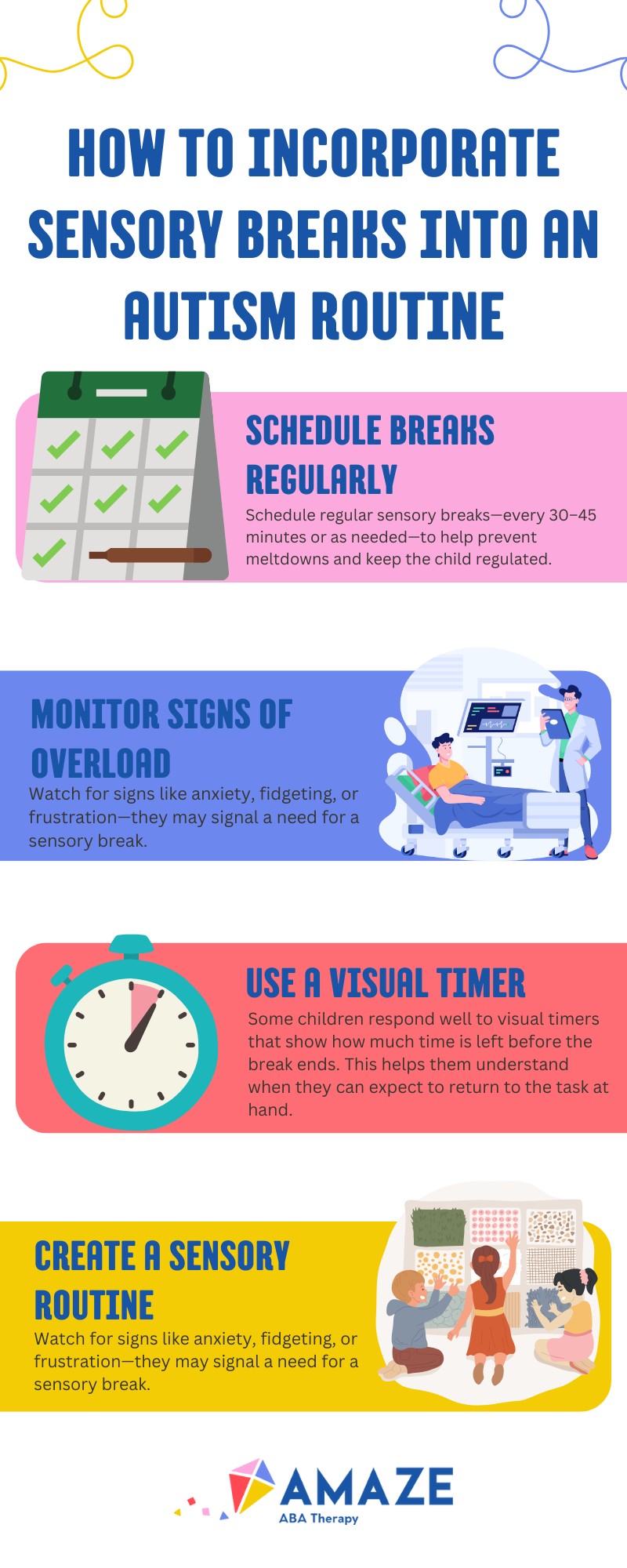Key Points:
- Sensory breaks are crucial for children with autism to manage sensory overload and improve focus.
- Incorporating various sensory activities into breaks can help regulate emotions and reduce anxiety.
- Simple, effective sensory break activities can make a big difference in a child’s ability to manage their day.
Sensory processing dysfunction is prevalent in up to 90% of autistic individuals. This can lead to overstimulation in environments filled with noise, bright lights, or fast movements. Sensory breaks are a powerful tool for managing this overload and allowing kids to recharge. An autism sensory break typically involves short periods of time where a child engages in activities designed to regulate their sensory input and prevent emotional overwhelm.
These breaks are an essential part of the daily routine for children with autism. They offer an opportunity to reset and return to tasks with a clearer mind and better emotional regulation. In this article, we will explore the benefits of sensory breaks for children with autism, share various activities to incorporate during these breaks, and offer tips on how to make the most of sensory breaks in everyday life.
What is an Autism Sensory Break?
An autism sensory break is a short period of time, typically 5-10 minutes, during which a child takes a break from sensory stimulation. The goal is to help the child process and regulate sensory input in a way that prevents sensory overload. Sensory overload can occur when a child is exposed to too much sensory input (such as loud noises, bright lights, or lots of movement), leading to stress, anxiety, or even meltdowns.
During a sensory break, the child might engage in activities that either stimulate or calm their senses, depending on their needs at the time. These activities can be tailored to address the child’s unique sensory preferences. For example, some children with autism might need calming activities like deep pressure or quiet spaces, while others may need more active, stimulating activities to help them feel more grounded.
The Importance of Sensory Breaks for Children with Autism
Sensory breaks are vital because they offer children with autism a chance to manage sensory overload, which can lead to improved emotional regulation, focus, and behavior. Here’s why they are important:
1. Prevents Sensory Overload
Continuous exposure to sensory input without breaks can cause anxiety and overwhelm. Sensory breaks allow children to process and recover from overstimulation.
2. Improves Focus and Attention
Sensory breaks allow for children to improve their attention and concentration. After a short break, children are often more able to concentrate and engage in activities without the distractions of sensory stress.
3. Supports Emotional Regulation
Sensory breaks provide a structured way for children to calm down when they feel overwhelmed, preventing meltdowns and improving their emotional resilience.
Incorporating sensory breaks throughout the day can have a lasting positive impact on a child’s ability to manage sensory challenges and navigate everyday situations more effectively.
Effective Sensory Break Activities for Kids with Autism
When considering sensory break activities, it’s important to recognize that every child’s sensory needs are different. Some children may benefit from calming activities that help them unwind, while others may need more engaging, stimulating activities to help them feel centered. Here are several activity suggestions that can be effective during sensory breaks:
1. Deep Pressure Activities
Deep-pressure activities can help children with autism feel more grounded and secure. These activities stimulate the proprioceptive sense (the sense of body position and movement), which can have a calming effect.
- Weighted blankets: Use a weighted blanket to provide deep pressure, helping the child feel more centered. This sensory input can have a calming effect and improve sleep by promoting relaxation and reducing anxiety.
- Firm hugs or squeezes: Giving the child a firm hug or asking them to squeeze a soft object, like a stress ball or squishy toy, can provide soothing pressure. This type of sensory feedback helps regulate emotions and can be particularly calming during stressful moments.
- Compression vests: A compression vest provides gentle pressure around the torso, offering a calming effect for children who need deep proprioceptive input. This constant pressure helps improve body awareness and can increase focus, especially in situations that may cause overstimulation.
2. Movement Breaks
Some children with autism need more active, stimulating activities to help regulate their sensory system. Movement-based sensory breaks are particularly useful for children who seek out proprioceptive or vestibular input (input related to balance and movement).
- Jumping on a trampoline: A mini-trampoline provides excellent sensory input and is a fun way to burn off energy.
- Swinging: Many children with autism enjoy swinging, as it provides calming vestibular input. Consider using a swing indoors or in a sensory room.
- Dancing or marching: Put on some music and encourage the child to dance or march. This activity is especially helpful for children who need to release built-up energy.
3. Calming Sensory Breaks
Calming breaks help children unwind and process sensory input when they feel overwhelmed. These activities help children soothe their nervous system and find a sense of calm.
- Quiet space or sensory corner: Create a calm, quiet space with soft lighting and calming sounds where the child can retreat when they need a break.
- Breathing exercises: Teach the child simple deep breathing exercises. Inhaling slowly through the nose and exhaling through the mouth can help calm the nervous system.
- Gentle rocking: Some children with autism benefit from the gentle rocking motion of a rocking chair, which provides a calming effect.
4. Fidgeting Tools
Fidget tools can be great for children who need tactile input. These tools help children focus and self-regulate by providing sensory input that is not overstimulating.
- Fidget spinners: A popular tool that helps children release energy in a controlled way. These toys provide a focused outlet for movement, which can help improve attention and reduce anxiety in children who struggle with staying still.
- Sensory balls: Soft, squishy balls that can be squeezed or rolled, offering tactile stimulation. The act of manipulating these balls can help children calm down, improve hand-eye coordination, and regulate sensory processing.
- Chew toys: For children who seek oral sensory input, chewable toys can provide calming stimulation. They can help children self-regulate during moments of stress or anxiety, and promote oral motor development while also serving as a calming distraction.
These sensory break activities can be tailored to suit your child’s preferences and needs. It’s important to observe which activities they respond to best and incorporate those into their routine. To better understand how different textures might influence your child’s responses, you might find our article, Understanding Sensory Textures in Autism, especially helpful.
How to Incorporate Sensory Breaks into Daily Life
Integrating sensory breaks into your child’s routine doesn’t have to be difficult. Here are some tips to ensure that sensory breaks are effective:

By thoughtfully incorporating sensory breaks into daily life, children with autism can better manage autism behaviors and feel more grounded throughout their day.
Get Support for Your Child’s Development with ABA Therapy
If you’re looking for additional support to help your child thrive, ABA therapy could be a great fit. ABA therapy helps with teaching autistic children important skills, including self-regulation, communication, and social skills. Incorporating sensory breaks alongside ABA therapy can provide a comprehensive approach to addressing sensory challenges.
At Amaze ABA, we offer personalized ABA therapy to children in Georgia, Nebraska, Maryland, and Virginia. Our team of experienced therapists is dedicated to helping your child achieve their goals in a supportive and encouraging environment. Contact us today to learn more about how ABA therapy can help your child develop and thrive.

